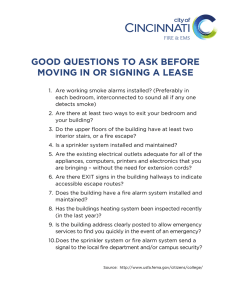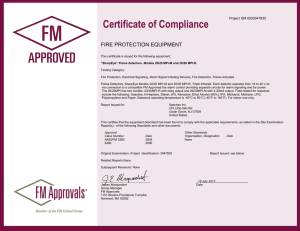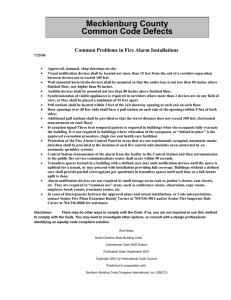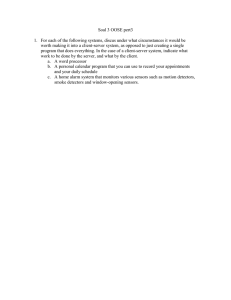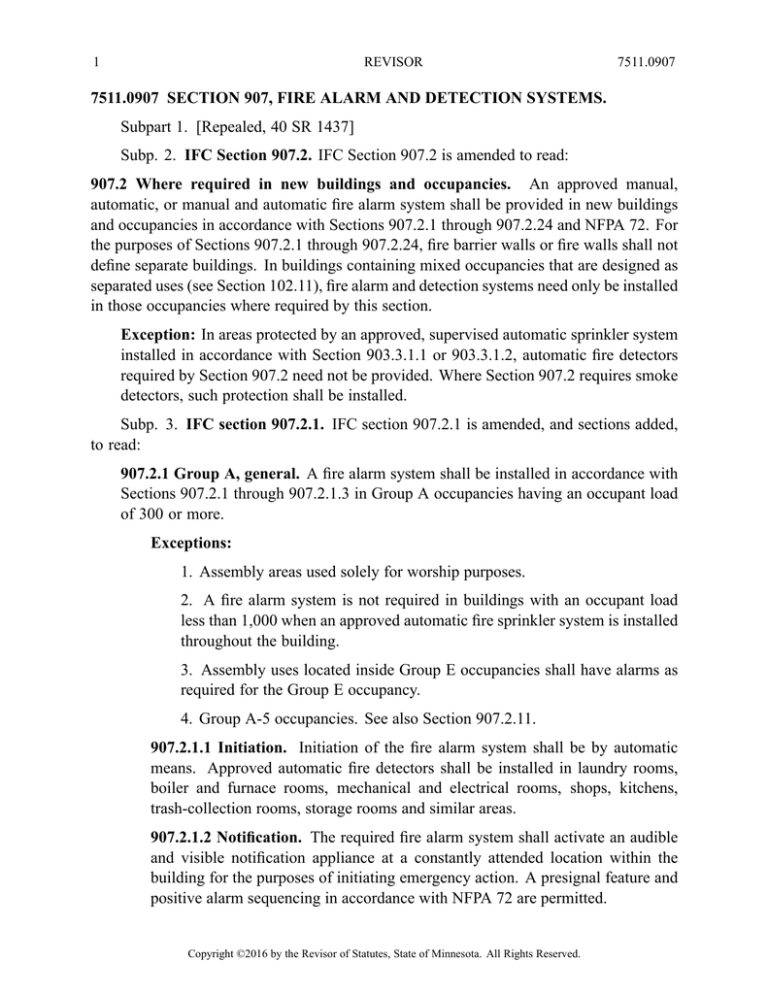
1
REVISOR
7511.0907
7511.0907 SECTION 907, FIRE ALARM AND DETECTION SYSTEMS.
Subpart 1. [Repealed, 40 SR 1437]
Subp. 2. IFC Section 907.2. IFC Section 907.2 is amended to read:
907.2 Where required in new buildings and occupancies. An approved manual,
automatic, or manual and automatic fire alarm system shall be provided in new buildings
and occupancies in accordance with Sections 907.2.1 through 907.2.24 and NFPA 72. For
the purposes of Sections 907.2.1 through 907.2.24, fire barrier walls or fire walls shall not
define separate buildings. In buildings containing mixed occupancies that are designed as
separated uses (see Section 102.11), fire alarm and detection systems need only be installed
in those occupancies where required by this section.
Exception: In areas protected by an approved, supervised automatic sprinkler system
installed in accordance with Section 903.3.1.1 or 903.3.1.2, automatic fire detectors
required by Section 907.2 need not be provided. Where Section 907.2 requires smoke
detectors, such protection shall be installed.
Subp. 3. IFC section 907.2.1. IFC section 907.2.1 is amended, and sections added,
to read:
907.2.1 Group A, general. A fire alarm system shall be installed in accordance with
Sections 907.2.1 through 907.2.1.3 in Group A occupancies having an occupant load
of 300 or more.
Exceptions:
1. Assembly areas used solely for worship purposes.
2. A fire alarm system is not required in buildings with an occupant load
less than 1,000 when an approved automatic fire sprinkler system is installed
throughout the building.
3. Assembly uses located inside Group E occupancies shall have alarms as
required for the Group E occupancy.
4. Group A-5 occupancies. See also Section 907.2.11.
907.2.1.1 Initiation. Initiation of the fire alarm system shall be by automatic
means. Approved automatic fire detectors shall be installed in laundry rooms,
boiler and furnace rooms, mechanical and electrical rooms, shops, kitchens,
trash-collection rooms, storage rooms and similar areas.
907.2.1.2 Notification. The required fire alarm system shall activate an audible
and visible notification appliance at a constantly attended location within the
building for the purposes of initiating emergency action. A presignal feature and
positive alarm sequencing in accordance with NFPA 72 are permitted.
Copyright ©2016 by the Revisor of Statutes, State of Minnesota. All Rights Reserved.
2
REVISOR
7511.0907
Occupant notification shall be by means of voice announcements, either live or
prerecorded, initiated by the person in the constantly attended location.
Exception: Where no constantly attended location exists, an automatic fire
alarm system providing a general evacuation signal or an approved emergency
voice/alarm communications system is permitted.
907.2.1.3 System initiation in Group A occupancies with occupant load of
1,000 or more. Activation of the fire alarm system in Group A occupancies
with an occupant load of 1,000 or more shall immediately initiate an approved
prerecorded message announcement using an approved emergency voice/alarm
communications system in accordance with NFPA 72.
Exception: Where approved, the prerecorded announcement is allowed to
be manually deactivated for a period of time, not to exceed three minutes, for
the sole purpose of allowing a live voice announcement from an approved,
constantly attended location.
Subp. 4. IFC section 907.2.2. IFC section 907.2.2 is amended, and sections added,
to read:
907.2.2 Group B, general. A fire alarm system shall be installed in accordance with
Sections 907.2.2 through 907.2.2.3 in Group B occupancies if:
1. The building has an occupant load of 500 or more persons;
2. The building has an occupant load of more than 100 persons above or below
the lowest level of exit discharge; or
3. The building contains an ambulatory care facility.
When automatic sprinkler systems or automatic fire detectors are installed in
ambulatory care facilities, such systems or detectors shall be connected to the building
fire alarm system.
Exception: In other than ambulatory care facilities, a fire alarm system is not
required when an approved automatic fire-extinguishing system is installed
throughout the building.
907.2.2.1 Initiation. Initiation of the fire alarm system shall be by automatic
means. Approved automatic fire detectors shall be provided in boiler and furnace rooms,
shops, kitchens, mechanical and electrical rooms, trash-collection rooms, storage rooms
and similar areas. In ambulatory care facilities, initiation of the fire alarm system shall also
be by manual means.
907.2.2.2 Notification. Activation of the fire alarm system shall initiate a general
evacuation signal.
Copyright ©2016 by the Revisor of Statutes, State of Minnesota. All Rights Reserved.
3
REVISOR
7511.0907
Exception: In lieu of audible notification appliances, visible notification
appliances shall be permitted to be used in patient care areas.
907.2.2.3 Ambulatory care facilities. Corridors and rooms or spaces open to
corridors within an ambulatory care facility shall be protected by an automatic
smoke-detection system.
Subp. 5. IFC section 907.2.3. IFC section 907.2.3 is amended, and sections added,
to read:
907.2.3 Group E, general. A fire alarm system shall be installed in accordance
with Sections 907.2.3 through 907.2.3.3 in Group E occupancies having an
occupant load of 50 or more.
907.2.3.1 Initiation. Initiation of the fire alarm system shall be by manual
and automatic means. Approved automatic fire detectors shall be provided in
laundry rooms, boiler and furnace rooms, mechanical and electrical rooms, shops,
laboratories, kitchens, locker rooms, custodial closets, trash-collection rooms,
storage rooms, lounges and similar areas.
Exceptions:
1. In buildings protected throughout by an approved fire sprinkler
system, manual fire alarm boxes are only required in the main office and
in a custodial area.
2. Where all corridors are protected by an approved automatic fire alarm
system having smoke detection with alarm verification, manual fire
alarm boxes are only required near exits serving shops, chemistry and
physics laboratories, boiler rooms, industrial technology and industrial
arts rooms, kitchens, custodian's offices and main offices.
907.2.3.2 Travel through adjoining rooms. Where the only means of egress
travel from an interior room or rooms having an aggregate occupant load of more
than ten occupants is through an adjoining or intervening room, automatic smoke
detectors shall be installed throughout the common atmosphere through which the
path of egress travel passes.
Exception: In buildings that are protected throughout by an approved
automatic sprinkler system installed in accordance with Section 903.3.1.1,
smoke detectors are not required in intervening or adjoining rooms.
907.2.3.3 Notification. Activation of the fire alarm system or automatic sprinkler
system shall initiate a general evacuation signal.
Subp. 6. IFC Section 907.2.4. IFC Section 907.2.4 is amended, and sections added,
to read:
Copyright ©2016 by the Revisor of Statutes, State of Minnesota. All Rights Reserved.
4
REVISOR
7511.0907
907.2.4 Group F, general. A fire alarm system shall be installed in accordance with
Sections 907.2.4 through 907.2.4.2 in Group F occupancies that are two or more stories in
height and have an occupant load of 500 or more above or below the lowest level of exit
discharge.
Exception: A fire alarm system is not required when an approved automatic
fire-extinguishing system is installed throughout the building.
907.2.4.1 Initiation. Initiation of the fire alarm system shall be by manual and
automatic means. Approved automatic fire detectors shall be provided in boiler and furnace
rooms, trash-collection rooms, kitchens, mechanical and electrical rooms, and similar areas.
907.2.4.2 Notification. Activation of the fire alarm system shall initiate a general
evacuation signal.
Subp. 7. IFC section 907.2.5. IFC section 907.2.5 is amended, and sections added,
to read:
907.2.5 Group H, general. A fire alarm system shall be installed in accordance with
Sections 907.2.5 through 907.2.5.2 in Group H-5 occupancies, occupancies used for
the manufacture of organic coatings and, when required by Chapters 60, 62, and 63, at
the following locations:
1. Rooms or areas where highly toxic compressed gases are stored or used;
2. Rooms or areas where Class I, II or III organic peroxides are stored; and
3. Liquid and solid oxidizer storage areas.
907.2.5.1 Initiation. Initiation of the fire alarm system in Group H-5 occupancies
and in occupancies used for the manufacture of organic coatings shall be by manual
means. Initiation of fire alarm systems installed for highly toxic gases, organic
peroxides and oxidizers shall be by automatic means, as specified in Chapters 60,
62, and 63.
907.2.5.2 Notification. Activation of the fire alarm system in Group H-5
occupancies and in occupancies used for the manufacture of organic coatings
shall initiate a general evacuation signal. Activation of the automatic detection
systems installed for highly toxic gases, organic peroxides and oxidizers shall
sound a local alarm.
Subp. 8. IFC section 907.2.6. IFC section 907.2.6 and all subsections are deleted in
their entirety and replaced with the following:
907.2.6 Group I, general. A fire alarm system shall be installed in accordance with
Sections 907.2.6 through 907.2.6.4.2 in Group I occupancies.
Copyright ©2016 by the Revisor of Statutes, State of Minnesota. All Rights Reserved.
5
REVISOR
7511.0907
907.2.6.1 Group I-1 occupancies, general. A manual and automatic fire alarm
system shall be installed in Group I-1 occupancies in accordance with Sections
907.2.6.1.1 through 907.2.6.1.3.
907.2.6.1.1 Initiation. Initiation of the fire alarm system shall be by manual
and automatic means. Approved automatic fire detectors shall be installed
in laundry and soiled linen rooms, boiler and furnace rooms, mechanical
and electrical rooms, shops, laboratories, kitchens, locker rooms, custodial
closets, trash-collection rooms, storage rooms, lounges, gift shops and similar
areas. Automatic smoke detectors shall be provided in corridors and areas that
are open to corridors.
Exception: Manual fire alarm boxes in patient sleeping areas of Group
I-1 occupancies shall not be required at exits if located at all nurses'
stations or other constantly attended staff locations, provided such fire
alarm boxes are visible and continuously accessible, if travel distances
required by Section 907.4.2 are not exceeded.
907.2.6.1.2 Notification. Activation of the fire alarm system or automatic
sprinkler system shall initiate a general evacuation signal. In addition,
activation of the fire alarm system shall immediately transmit an alarm to an
approved central station or remote station service.
Exceptions:
1. In lieu of audible notification appliances, visible notification
appliances shall be allowed to be used in critical care areas.
2. Where occupants are incapable of evacuating themselves because
of age, physical/mental disabilities or physical restraint, only the
attendants or other personnel required to evacuate occupants from
a zone, area, floor or building shall be required to be notified. This
notification shall include means to readily identify the zone, area,
floor or building in need of evacuation.
907.2.6.1.3 Sleeping room smoke alarms. Smoke alarms shall be installed
in resident sleeping rooms in accordance with Section 907.2.11.1.
907.2.6.2 Group I-2 occupancies, general. A manual and automatic fire alarm
system shall be installed in Group I-2 occupancies in accordance with Sections
907.2.6.2 through 907.2.6.2.4.
907.2.6.2.1 Initiation. Initiation of the fire alarm system shall be by manual
and automatic means. Approved automatic fire detectors shall be installed
in laundry and soiled linen rooms, boiler and furnace rooms, mechanical
and electrical rooms, shops, laboratories, kitchens, locker rooms, custodial
Copyright ©2016 by the Revisor of Statutes, State of Minnesota. All Rights Reserved.
6
REVISOR
7511.0907
closets, trash-collection rooms, storage rooms, lounges, gift shops, and
similar areas. Hospitals, nursing homes (both intermediate care and skilled
nursing facilities), board and care homes, and detoxification facilities shall
be provided with smoke detection throughout the corridor and areas open to
the corridors, other than nurse's stations.
Exceptions:
1. Corridor smoke detection shall not be required where the sleeping
room smoke detectors required in Section 907.2.6.2.3 are connected
to an approved fire alarm system and activate a general evacuation
signal.
2. Manual fire alarm boxes shall not be required at exits from patient
sleeping areas if located at all nurses' stations or other constantly
attended staff locations, provided such fire alarm boxes are visible
and continuously accessible and that travel distances horizontally,
on the same floor shall not exceed 200 feet to reach a manual fire
alarm box.
907.2.6.2.2 Notification. Activation of the fire alarm system or automatic
sprinkler system shall initiate a signal that is distinctive from audible signals
used for other purposes in the same building. Such signal is intended to
notify staff and need not meet the minimum sound pressure levels required
for general evacuation fire alarm notification. In addition, activation of the
fire alarm system shall immediately transmit an alarm to an approved central
station or remote station service.
Exceptions:
1. In lieu of audible notification appliances, visible notification
appliances shall be allowed to be used in critical care areas.
2. Where occupants are incapable of evacuating themselves because
of age, physical/mental disabilities, or physical restraint, only the
attendants or other personnel required to evacuate occupants from a
zone, area, floor, or building shall be required to be notified. This
notification shall include means to readily identify the zone, area,
floor, or building in need of evacuation.
3. Where total evacuation of occupants is impractical due to
building configuration, only the occupants in the affected zones
shall be initially notified. Provisions shall be made to selectively
notify occupants in other zones to afford orderly evacuation of the
entire building.
Copyright ©2016 by the Revisor of Statutes, State of Minnesota. All Rights Reserved.
7
REVISOR
7511.0907
907.2.6.2.3 Patient room smoke detectors. Smoke detectors shall be
installed in patient sleeping rooms of hospitals and nursing homes. Such
detector's primary power shall be other than battery power. Actuation of
such detectors shall cause a visual display on the corridor side of the room
where the detector is located and shall cause a distinct audible and visual
alarm at the nurse's station attending the room. Such detectors may be part of
the facility's fire alarm system, nurse's call system, or a standalone system.
907.2.6.2.3.1 Integral smoke detectors for automatic door-closing
devices. Integral smoke detectors for automatic door-closing devices on
sleeping room doors can meet the requirement for patient room smoke
detectors found in section 907.2.6.2.3 provided they perform all the
required alerting functions found in section 907.2.6.2.3.
907.2.6.2.4 Sleeping room smoke alarms. For Group I-2 facilities, other
than hospitals and nursing homes, single station smoke alarms shall be
installed in resident sleeping rooms.
907.2.6.3 Group I-3 occupancies, general. A manual and automatic fire alarm
system shall be installed in Group I-3 occupancies in accordance with Sections
907.2.6.3 through 907.2.6.3.4.
907.2.6.3.1 Initiation. Initiation of the fire alarm system shall be by
manual and automatic means. Approved automatic fire detectors shall
be installed in laundry and soiled linen rooms, boiler and furnace rooms,
mechanical and electrical rooms, shops, laboratories, kitchens, locker rooms,
custodial closets, trash-collection rooms, storage rooms, lounges, gift shops,
commissaries and similar areas. Actuation of an automatic fire-extinguishing
system, a manual fire alarm box or a fire detector shall initiate an approved
fire alarm signal, which automatically notifies staff. Presignal systems shall
not be used.
907.2.6.3.2 Manual fire alarm boxes. Manual fire alarm boxes are not
required to be located in accordance with Section 907.4 where the fire alarm
boxes are provided at staff-attended locations having direct supervision over
areas where manual fire alarm boxes have been omitted.
Manual fire alarm boxes are permitted to be locked in areas occupied by detainees,
provided that staff members are present within the subject area and have keys readily
available to operate the manual fire alarm boxes.
907.2.6.3.3 Smoke detectors. An approved automatic smoke-detection
system shall be installed throughout resident housing areas, including
Copyright ©2016 by the Revisor of Statutes, State of Minnesota. All Rights Reserved.
8
REVISOR
7511.0907
sleeping areas and contiguous day rooms, group activity spaces and other
common spaces normally accessible to residents.
Exceptions:
1.
Other approved smoke-detection arrangements providing
equivalent protection, such as placing detectors in exhaust ducts
from cells or behind protective grills, are allowed when necessary
to prevent damage or tampering.
2. Smoke detectors are not required in sleeping rooms with four
or fewer occupants in smoke compartments that are equipped
throughout with an approved automatic sprinkler system.
907.2.6.3.4 Notification. Activation of the fire alarm system or automatic
sprinkler system shall initiate a signal that is distinctive from audible signals
used for other purposes in the same building. Such signal is intended to
notify staff and need not meet the minimum sound pressure levels required
for general evacuation fire alarm notification. In addition, activation of the
fire alarm system shall immediately transmit an alarm to an approved central
station or remote station service.
907.2.6.4 Group I-4 occupancies, general. A manual and automatic fire alarm
system shall be installed in Group I-4 occupancies in accordance with Sections
907.2.6.4.1 through 907.2.6.4.2.
907.2.6.4.1 Initiation. Initiation of the fire alarm system shall be by manual
and automatic means. Approved automatic fire detectors shall be installed
in laundry and soiled linen rooms, boiler and furnace rooms, mechanical
and electrical rooms, shops, laboratories, kitchens, locker rooms, custodial
closets, trash-collection rooms, storage rooms, lounges, gift shops, and
similar areas. Automatic smoke detectors shall be provided in corridors and
areas that are open to corridors.
907.2.6.4.2 Notification. Activation of the fire alarm system or automatic
sprinkler system shall initiate a general evacuation signal. In addition,
activation of the fire alarm system shall immediately transmit an alarm signal
to an approved central station or remote station service.
Subp. 9. IFC Section 907.2.7. IFC Section 907.2.7 and all subsections are deleted in
their entirety.
Subp. 10. IFC section 907.2.8. IFC section 907.2.8 and all subsections are deleted in
their entirety and replaced with the following:
Copyright ©2016 by the Revisor of Statutes, State of Minnesota. All Rights Reserved.
9
REVISOR
7511.0907
907.2.8 Group R-1, general. A fire alarm system shall be installed in accordance with
Sections 907.2.8 through 907.2.8.3 in Group R-1 occupancies.
Exceptions:
1. A fire alarm system is not required in buildings not over two stories in
height where all individual sleeping units and contiguous attic and crawl
spaces are separated from each other and public or common areas by at least
one-hour fire partitions and each sleeping unit has an exit directly to a public
way, exit court or yard.
2. Buildings containing five or fewer sleeping units shall be allowed to be
equipped with approved multiple-station smoke alarms installed as required
for Group R-3 occupancies. Installation shall be in accordance with Section
907.2.11.
907.2.8.1 Initiation. Initiation of the fire alarm system shall be by automatic
means. Approved automatic fire detectors shall be provided in boiler and furnace
rooms, shops, laundry rooms, mechanical and electrical rooms, trash-collection
rooms, storage rooms, gift shops, locker rooms and similar areas. Automatic
smoke detectors shall be provided in all common areas and interior corridors
serving as required means of egress.
Exception: System fire and smoke detectors are not required when an
approved automatic fire-extinguishing system is installed in accordance with
Section 903.3.1.1 or 903.3.1.2 and a manual fire alarm box is provided at
a constantly attended location. When a constantly attended location is not
provided, the manual fire alarm box shall be provided at the main exit.
907.2.8.2 Notification. Activation of the fire alarm system or automatic sprinkler
system shall initiate a general evacuation signal.
907.2.8.3 Sleeping unit smoke alarms. Sleeping unit smoke alarms required by
Section 907.2.11 shall not be connected to a fire alarm system.
Exception: Connection of such alarms for annunciation only.
Subp. 11. IFC section 907.2.9. IFC section 907.2.9 is amended, and sections added,
to read:
907.2.9 Group R-2, general. A fire alarm system shall be installed in accordance with
Sections 907.2.9 through 907.2.9.2 in Group R-2 occupancies where:
1. Any sleeping unit or dwelling unit is located two or more stories above the story
containing the lowest level of exit discharge;
Copyright ©2016 by the Revisor of Statutes, State of Minnesota. All Rights Reserved.
10
REVISOR
7511.0907
2. Any sleeping unit or dwelling unit is located more than one story below the
highest level of exit discharge of exits serving the dwelling unit;
3. The building contains more than 16 dwelling units or sleeping units; or
4. The building is used as a congregate living facility, dormitory, convent,
monastery, fraternity, sorority, group home, or shelter and has an occupant load
of 20 or more.
Exception: A fire alarm system is not required in buildings not over two
stories in height where all dwelling units and contiguous attic and crawl
spaces are separated from each other and public or common areas by at least
one-hour fire partitions and each dwelling unit has an exit directly to a public
way, exit court or yard.
907.2.9.1 Initiation. Initiation of the fire alarm system shall be by automatic
means. Automatic fire detectors shall be provided in boiler and furnace rooms,
trash-collection rooms, shops, laundry rooms, mechanical and electrical rooms,
storage rooms and similar areas. Automatic smoke detectors shall be provided in
all common areas and interior corridors serving as a required means of egress.
Exception: System fire and smoke detectors are not required when an
approved automatic fire-extinguishing system is installed throughout the
building.
907.2.9.2 Notification. Activation of the fire alarm system or automatic sprinkler
system shall initiate a general evacuation signal.
907.2.9.3 Dwelling unit smoke alarms. Dwelling unit smoke alarms required by
Section 907.2.11 shall not be connected to the building fire alarm system.
Exception: Connection of such alarms for annunciation only.
Subp. 11a. IFC section 907.2.10. IFC section 907.2.10 is amended to read as follows:
907.2.10 Group R-4, general. A fire alarm system shall be installed in accordance
with Sections 907.2.10 through 907.2.10.3 in Group R-4 occupancies.
Exceptions:
1. A fire alarm system is not required in buildings two stories or less in height
where all individual sleeping units and contiguous attic and crawl spaces to
those units are separated from each other and public or common areas by at
least one-hour fire partitions and each sleeping unit room has an exit directly
to a public way, exit court, or yard.
2. Buildings containing five or fewer sleeping units shall be allowed to be
equipped with approved multiple-station smoke alarms installed as required
Copyright ©2016 by the Revisor of Statutes, State of Minnesota. All Rights Reserved.
11
REVISOR
7511.0907
for Group R-3 occupancies. Installation shall be in accordance with Section
907.2.11.
907.2.10.1 Initiation. Initiation of the fire alarm system shall be by automatic
means. Approved automatic fire detectors shall be provided in boiler and furnace
rooms, shops, laundry rooms, mechanical and electrical rooms, trash-collection
rooms, storage rooms, gift shops, locker rooms, and similar areas. Automatic
smoke detectors shall be provided in all common areas and interior corridors
serving as required means of egress.
Exception: System fire and smoke detectors are not required when an
approved automatic fire-extinguishing system is installed in accordance with
section 903.3.1.1, 903.3.1.2, or 903.3.1.3.
907.2.10.2 Notification. Activation of the fire alarm system or automatic sprinkler
system shall initiate a general evacuation signal.
907.2.10.3 Smoke alarms. Single and multistation smoke alarms shall be installed
in accordance with Section 907.2.11.
Subp. 12. [Repealed, 40 SR 1437]
Subp. 13. IFC section 907.2.11.4. IFC section 907.2.11.4 is amended by numbering
the existing exception and adding a new exception, so that the exceptions read as follows:
Exceptions:
1. Smoke alarms are not required to be equipped with battery backup in
Group R-1 where they are connected to an emergency electrical system.
2. Smoke alarms are not required to be equipped with battery backup in
Group R-2 occupancies equipped throughout with an automatic sprinkler
system installed in accordance with Section 903.3.1.1 or 903.3.1.2.
3. Smoke alarms installed in sleeping rooms of Group R-3 buildings
equipped throughout with an automatic sprinkler system installed in
accordance with Section 903.3.1.1, 903.3.1.2, or 903.3.1.3 are allowed
to be battery-powered.
Subp. 14. [Repealed, 40 SR 1437]
Subp. 15. IFC Section 907.2. IFC Section 907.2 is amended by adding sections to
read:
907.2.24 Residential hospices. A fire alarm system shall be installed in accordance
with Section 907.2.24 in residential hospices. When automatic sprinkler systems or
automatic fire detectors are installed, such systems or detectors shall be connected to the
building fire alarm system.
Copyright ©2016 by the Revisor of Statutes, State of Minnesota. All Rights Reserved.
12
REVISOR
7511.0907
907.2.24.1 Initiation. Initiation of the fire alarm system shall be by manual and
automatic means. Approved automatic fire detectors shall be provided in boiler and furnace
rooms, kitchens, laboratories, shops, gift shops, commissaries, laundry and soiled linen
rooms, mechanical and electrical rooms, locker rooms, storage rooms, janitors' closets,
trash-collection rooms, lounges and similar areas. Automatic smoke detectors shall be
provided in sleeping rooms, corridors and spaces open to the corridors.
Exception: Manual fire alarm boxes are not required at exits if manual fire alarm boxes
are located at all nurses' stations or other constantly attended staff locations, provided
such fire alarm boxes are visible and continuously accessible and that travel distances
required by Section 907.4.1 are not exceeded.
907.2.24.2 Notification. Activation of the fire alarm system or automatic sprinkler
system shall initiate a general evacuation signal. In addition, the fire alarm system shall be
monitored by an approved central station service in accordance with Section 903.4.1.
Exception: In lieu of audible notification appliances, visible notification appliances
shall be allowed to be used in sleeping areas.
Subp. 15a. IFC section 907.3.IFC section 907.3 is amended and sections added to
read:
907.3 Fire safety functions. Automatic fire detectors required by Section 907.2 and
Chapter 11 are to activate notification appliances in accordance with those sections. When
automatic fire detectors are installed for other fire safety functions, they shall perform the
intended function upon activation. When automatic detectors are installed for fire safety
functions and the building has a fire alarm system, the detectors shall activate supervisory
signals at the fire alarm control panel or at a constantly attended location. When the
building does not have a fire alarm system, the detectors shall activate a visual and audible
supervisory signal at an approved location, which shall indicate the source of the signal.
907.3.1 Air distribution and air-handling systems. Smoke detectors installed to
shut down the air distribution or air-handling system shall, upon activation, perform
the intended function. Air distribution or air-handling equipment that is part of
a smoke-control system shall switch to smoke-control mode upon activation of a
detector.
907.3.1.1 Fire alarm system interface. Smoke detectors that are installed in air
distribution or air-handling systems for shutdown purposes and that are connected
to a fire alarm system shall not sound a general evacuation signal.
907.3.2 Elevator control functions. Smoke detectors that are installed to control or
recall elevators or to control doors for elevators, elevator lobbies, or elevator shafts
and that are connected to a fire alarm system shall not sound a general evacuation
signal. Elevator recall and firefighter's emergency operation for elevators shall only be
Copyright ©2016 by the Revisor of Statutes, State of Minnesota. All Rights Reserved.
13
REVISOR
7511.0907
controlled by elevator smoke detectors and shall not initiate upon other building fire
detectors or evacuation signals.
907.3.3 Door hold-open functions. Smoke detectors that are installed to hold open fire
doors under nonemergency conditions and that are connected to a fire alarm system
shall sound a general evacuation signal when the doors being held open are part of
the means of egress corridor or stair system. Door hold-open smoke detectors are not
required to activate a visual or audible signal.
Subp. 15b. IFC section 907.6.5. IFC section 907.6.5 is deleted.
Subp. 16. [Repealed, 40 SR 1437]
Subp. 17. [Repealed, 40 SR 1437]
Subp. 18. [Repealed, 40 SR 1437]
Subp. 19. [Repealed, 40 SR 1437]
Subp. 20. [Repealed, 40 SR 1437]
Subp. 21. [Repealed, 40 SR 1437]
Subp. 22. [Repealed, 40 SR 1437]
Subp. 23. [Repealed, 40 SR 1437]
Subp. 24. [Repealed, 40 SR 1437]
Subp. 25. IFC section 907.8.2. IFC section 907.8.2 is amended to read:
907.8.2 Testing. Fire alarm systems shall be inspected and tested at least annually in
accordance with NFPA 72 or more frequently where required by the code official.
Exception: Devices or equipment that are inaccessible for safety considerations
shall be tested during scheduled shutdowns where approved by the code official,
but not less than every 18 months.
Statutory Authority: MS s 299F.011; 326B.02
History: 32 SR 10; 36 SR 1479; 40 SR 1437
Published Electronically: May 12, 2016
Copyright ©2016 by the Revisor of Statutes, State of Minnesota. All Rights Reserved.

